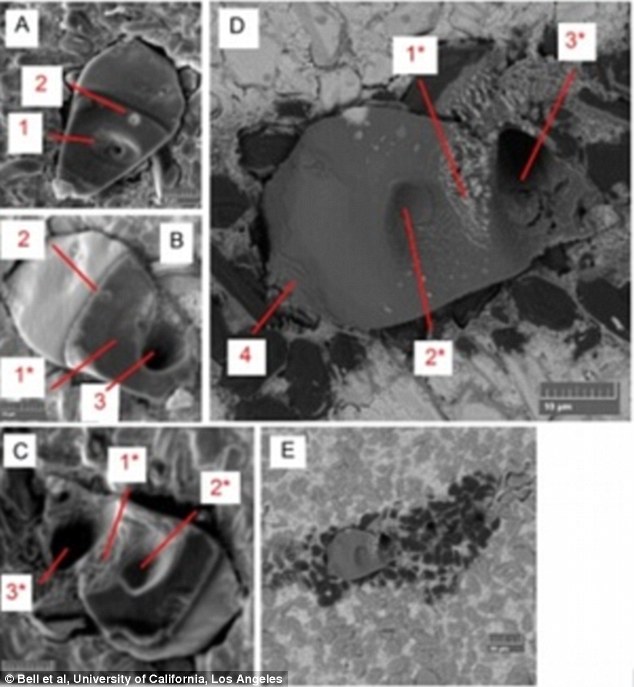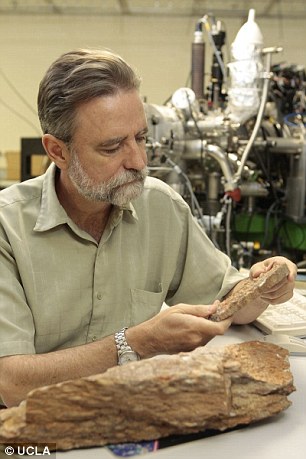fossilshk
(Lung)
管理員
  








UID 1
精華
23
積分 4775
帖子 2827
閱讀權限 200
註冊 2006-7-14
來自 中國/香港
狀態 離線
|
[廣告]:
澳洲發現41億年前地球最早的新命痕跡 (英文)
Life on Earth began 'almost instantaneously' 300 MILLION years earlier than we thought, claim scientists
Researchers discovered the evidence in specks of graphite trapped
Trapped in immensely old zircon crystals from Western Australia
If confirmed, results would prove living organisms existed on Earth as long as 4.1bn years ago
Living organisms may have existed on Earth as long as 4.1bn years ago – 300m years earlier than was previously thought, new research has shown.
If confirmed, the discovery means life emerged a remarkably short time after the Earth was formed from a primordial disc of dust and gas surrounding the sun 4.6bn years ago.
Researchers discovered the evidence in specks of graphite trapped within immensely old zircon crystals from Jack Hills, Western Australia.

Electron microscope images taken during the analysis of the graphite specks, which were trapped within immensely old zircon crystals.
'Twenty years ago, this would have been heretical; finding evidence of life 3.8 billion years ago was shocking,' said Mark Harrison, co-author of the research and a professor of geochemistry at UCLA.
'Life on Earth may have started almost instantaneously,' added Harrison, a member of the National Academy of Sciences.
'With the right ingredients, life seems to form very quickly.'
The new research suggests that life existed prior to the massive bombardment of the inner solar system that formed the moon's large craters 3.9 billion years ago.
Atoms in the graphite, a crystalline form of carbon, bore the hallmark of biological origin.
They were enriched with 12C, a 'light' carbon isotope, or atomic strain, normally associated with living things.
It suggests that a terrestrial biosphere had emerged on Earth as early as 4.1bn years ago, said the scientists writing in the journal Proceedings of the National Academy of Sciences.
'If all life on Earth died during this bombardment, which some scientists have argued, then life must have restarted quickly,' said Patrick Boehnke, a co-author of the research and a graduate student in Harrison's laboratory.
Scientists had long believed the Earth was dry and desolate during that time period.
Harrison's research — including a 2008 study in Nature he co-authored with Craig Manning, a professor of geology and geochemistry at UCLA, and former UCLA graduate student Michelle Hopkins — is proving otherwise.
'The early Earth certainly wasn't a hellish, dry, boiling planet; we see absolutely no evidence for that,' Harrison said.
'The planet was probably much more like it is today than previously thought.'
The researchers, led by Elizabeth Bell — a postdoctoral scholar in Harrison's laboratory — studied more than 10,000 zircons originally formed from molten rocks, or magmas, from Western Australia.
Zircons are heavy, durable minerals related to the synthetic cubic zirconium used for imitation diamonds.
They capture and preserve their immediate environment, meaning they can serve as time capsules.
The scientists identified 656 zircons containing dark specks that could be revealing and closely analyzed 79 of them with Raman spectroscopy, a technique that shows the molecular and chemical structure of ancient microorganisms in three dimensions.
Bell and Boehnke, who have pioneered chemical and mineralogical tests to determine the condition of ancient zircons, were searching for carbon, the key component for life.
One of the 79 zircons contained graphite — pure carbon — in two locations.
'The first time that the graphite ever got exposed in the last 4.1 billion years is when Beth Ann and Patrick made the measurements this year,' Harrison said.
Researchers say they are 'Very confident,' their zircon represents 4.1 billion-year-old graphite.
'There is no better case of a primary inclusion in a mineral ever documented, and nobody has offered a plausible alternative explanation for graphite of non-biological origin into a zircon.'
The graphite is older than the zircon containing it, the researchers said.
They know the zircon is 4.1 billion years old, based on its ratio of uranium to lead; they don't know how much older the graphite is.
The research suggests life in the universe could be abundant, Harrison said.

Mark Harrison, co-author of the research and a professor of geochemistry at UCLA.
On Earth, simple life appears to have formed quickly, but it likely took many millions of years for very simple life to evolve the ability to photosynthesize.
The carbon contained in the zircon has a characteristic signature — a specific ratio of carbon-12 to carbon-13 — that indicates the presence of photosynthetic life.
'We need to think differently about the early Earth,' Bell said.
The US scientists, led by Dr Mark Harrison, from the University of California at Los Angeles, said the graphite was completely encased in zircon that was crack-free and could not have been contaminated despite the passing of aeons.
They wrote: 'This study extends the terrestrial carbon isotope record around 300m years beyond the previously oldest-measured samples from south-west Greenland.'
Some non-biological processes could also produce the light form of carbon, notably meteorite impacts, said the researchers.
But the amount of extra-terrestrial carbon needed to account for the findings made meteorites an unlikely source.
'A biogenic origin seems at least as plausible,' the scientists added.
Confirming the connection with early life would represent 'a potentially transformational scientific advance' they said.
'Our interpretation that the light C isotope signature in primary graphitic inclusions could reflect biologic processes is consistent with an estimate from molecular divergence in prokaryote phylogenetic relationships that a terrestrial biosphere had emerged by 4.1 Ga (36).
'However, given the low occurrence of carbon-bearing Hadean zircons, establishing a Hadean carbon cycle and its possible bearing on the origin of life will require enormous and sustained efforts.'
http://www.dailymail.co.uk/scien ... aim-scientists.html
| 
 |
|



